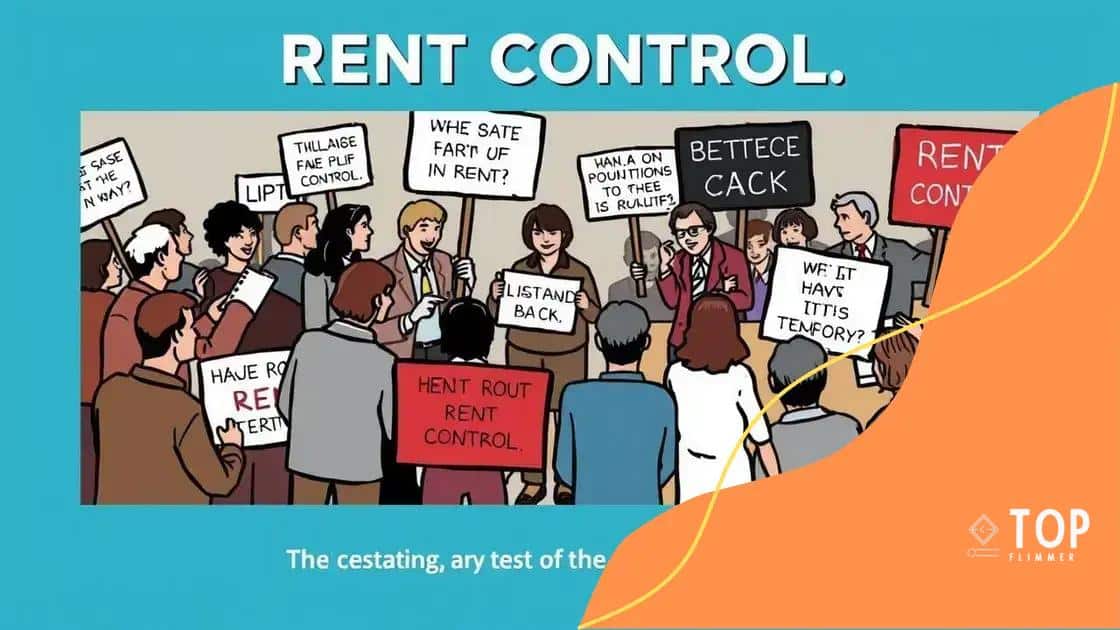Nationwide rent control advocacy: what you should know

Nationwide rent control advocacy focuses on implementing policies that keep rental prices affordable, ensuring tenant protection while promoting housing stability and community diversity.
Nationwide rent control advocacy is becoming a vital focus in housing discussions as cities face rising costs. Have you wondered how this movement might affect your community? Let’s delve into its implications.
Understanding nationwide rent control advocacy
Understanding nationwide rent control advocacy is crucial in today’s housing market. As rental prices soar, many advocates push for measures that protect tenants. This advocacy addresses significant issues, ensuring that housing remains affordable for all.
The Basics of Rent Control
At its core, rent control limits how much landlords can charge for rent. The goal is to prevent sudden and dramatic increases, enabling tenants to stay in their homes longer. This system can vary widely from state to state, resulting in different regulations and impact levels.
Importance of Rent Control
Advocacy for nationwide rent control is not merely a local concern; it touches broader economic and social issues:
- Protects tenants from eviction due to rising costs.
- Stabilizes neighborhoods that may be experiencing rapid gentrification.
- Helps vulnerable populations, such as the elderly or low-income families.
Many believe that effective rent control can lead to greater community stability. When people can afford their homes, they tend to invest in their neighborhoods. This stability can foster social connections and enhance community engagement.
Current Movements
Across the country, movements are emerging to advocate for stronger rent controls. In many cities, grassroots organizations gather support from tenants who face unaffordable rent. These movements use various tactics, from public rallies to legislative lobbying.
Collaboration is vital. Many non-profits and housing organizations partner to amplify their voices. Together, they push for legislation that not only focuses on rent control but also addresses associated housing policies.
Overall, understanding the intricacies of nationwide rent control advocacy can empower individuals. As awareness grows, communities can better advocate for their housing needs and influence policy decisions.
The economic impact of rent control policies
The economic impact of rent control policies is a complex topic that affects not only tenants but also landlords and the overall housing market. By managing rental prices, rent control aims to provide affordable housing, yet it also brings various economic consequences.
Benefits of Rent Control
A primary benefit of rent control is the stabilization of housing costs. When rents are capped, tenants can plan their budgets more effectively without the fear of sudden price hikes. This leads to a more stable community where families can thrive. Moreover, it can help maintain diversity in neighborhoods by preventing wealthier individuals from displacing low-income residents.
Challenges for Landlords
While there are benefits, landlords also face challenges under rent control policies. Many argue that caps on rent limits their ability to cover upkeep costs. Essential repairs and improvements may go neglected due to budget constraints. Consequently, some landlords may withdraw their properties from the rental market, leading to reduced housing availability.
- Potential decline in property maintenance.
- Reduced incentive for new housing development.
- Possibility of a housing shortage over time.
Balancing the needs of both tenants and landlords is key. Some experts suggest a middle-ground approach that allows moderate increases in rent while ensuring tenant protection.
Long-Term Economic Considerations
The long-term effects of rent control can influence local economies. When housing remains affordable, it can promote consumer spending. Residents have more disposable income for local businesses, leading to economic growth in the area. However, overly strict regulations could deter new investments in housing, which may hold back economic development.
Understanding the full spectrum of the economic impact is essential for policymakers. With nuanced and fair approaches, they can craft rent control solutions that balance affordability with economic vitality.
Arguments for and against rent control

The topic of rent control brings strong opinions on both sides. Understanding the arguments for and against it can help in grasping its impact on the housing market.
Arguments in Favor of Rent Control
Supporters of rent control argue that it plays a vital role in protecting tenants. One of the primary reasons people advocate for this measure is to prevent rent hikes that can lead to displacement. Many families struggle to afford basic housing, and rent control helps maintain stability in communities.
- It ensures affordable housing options for low-income residents.
- Rent control can promote long-term tenancy, enhancing neighborhood stability.
- Helps protect vulnerable populations, such as the elderly and low-income families.
Additionally, rent control can reduce socioeconomic disparities in urban areas. When people can live in their communities without fear of sudden rent increases, they can more easily engage in local labor markets and contribute to community well-being.
Arguments Against Rent Control
On the other hand, critics of rent control often argue that it can lead to housing shortages. When landlords are restricted in how much they can charge, they may choose to withdraw their properties from the rental market. This can create fewer available rental units.
- Reduces incentives for landlords to maintain or improve properties.
- Can lead to a decline in investment in new housing developments.
- May encourage landlords to convert rental units into condos or other types of real estate.
Furthermore, opponents argue that rent control can negatively impact the overall economy. By limiting rental income potential, there may be a ripple effect on local businesses and investments. Economists contend that affordable housing is essential, but it should not come at the cost of market viability.
Success stories from regions with rent control
Success stories from regions with rent control showcase how effective policies can positively impact communities. These examples demonstrate that well-implemented rent control can lead to stable housing markets and healthier neighborhoods.
San Francisco’s Rent Control Measures
San Francisco has some of the oldest rent control laws in the United States. These regulations have helped maintain a diverse population, allowing families and low-income residents to remain in the city. The rent control system in place has led to stability in many neighborhoods, even amid rising living costs.
New York City’s Rent Stabilization
In New York City, rent stabilization has been in effect for decades. This program has provided tenants with long-term affordability, preserving the city’s diversity. Many tenants in rent-stabilized apartments have enjoyed the benefits of predictable rent increases, fostering a sense of community and security.
- Enhanced tenant stability in long-term rentals.
- Reduced eviction rates in stabilized housing.
- Promoted neighborhood engagement among residents.
These factors contribute to stronger community ties and economic growth over time. As residents feel secure in their homes, they are more likely to invest their time and resources into the community.
Berlin’s Housing Model
Berlin is another notable example where rent control has made a significant impact. The city’s laws allow for reasonable rent caps, providing affordable housing options for residents. This model has demonstrated that cities can offer housing solutions without sacrificing quality.
In Berlin, tenants report a high level of satisfaction, thanks to stable rents. Local businesses benefit too, as residents have more disposable income to spend. This balance leads to thriving neighborhoods where both residents and businesses can succeed.
How to get involved in rent control advocacy
Getting involved in rent control advocacy is essential for those who want to support affordable housing initiatives. There are many ways to engage in this movement, and every little effort helps achieve significant change.
Educate Yourself and Others
One of the first steps in advocacy is to educate yourself about local housing issues. Understanding the principles of rent control and its effects on communities can better equip you to discuss these topics.
- Read local and national housing policy articles.
- Join online forums or community groups that discuss rent control.
- Attend workshops or seminars focused on housing advocacy.
As you gain knowledge, share it with friends, family, and co-workers. Conversations about the importance of rent control can help create awareness in your community.
Join Local Advocacy Groups
Becoming a member of local advocacy groups allows you to connect with others who share your passion. These organizations often work directly with lawmakers to push for policies that support affordable housing.
Participating in group activities can also enhance your understanding and impact. Many groups organize:
- Community meetings to discuss local housing issues.
- Protests or rallies advocating for rent control policies.
- Petitions to gather support for housing initiatives.
Collaboration with others amplifies your voice. Together, you can advocate for change more effectively than alone.
Engage with Policymakers
Contacting local officials and expressing your opinions can influence housing policies. You can write emails, make phone calls, or schedule meetings with policymakers to discuss the importance of rent control.
Prepare your key points in advance to convey your message clearly. Sharing personal stories or local data can make a strong case for advocating for rent control measures.
Your participation in public hearings on housing policies is valuable. Many cities hold these sessions, where community members can voice their concerns and recommendations. Active involvement in these events can catch the attention of decision-makers.
FAQ – Frequently Asked Questions about Nationwide Rent Control Advocacy
What is rent control advocacy?
Rent control advocacy is the effort to promote policies that keep rental prices affordable and protect tenants from sudden price hikes.
How can I get involved in rent control advocacy?
You can get involved by educating yourself, joining local advocacy groups, and contacting policymakers to express your support for rent control measures.
What are the benefits of rent control?
Rent control helps maintain affordable housing options, supports community stability, and protects vulnerable tenants from eviction.
Are there any drawbacks to rent control?
Some argue that rent control can lead to housing shortages and reduce maintenance and investment in rental properties.






